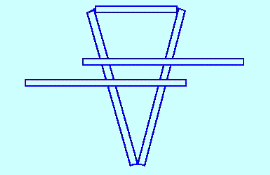

Brüel Acoustics
Transparent Standing Wave Tube SWT
40BA
For more than 65 years we have measured a material's
acoustic absorption effectiveness in a Standing Wave Tube (SWT) (fig.l).
The
probe is installed at the end of a long tube.
At the other end of the tube a
loudspeaker radiates a pure tone along the tube to the sample under examination.
The sound is partly reflected from the sample and interference is generated
which produces sound pressure maxima (p,,x) and minima (p min) along the tube.
The ratio between the maximum and the minimum is defined using a microphone
or a microphone probe and through this the acoustical absorption co-efficient
(d) is found.
Normally the SWT will be used in a horizontal position
to allow the microphone or the probe to move.
Although this method
is easy and accurate it has only limited use as the SWT is in the horizontal
position and the probe is sitting vertically.
Most acoustical absorbing material is used on
ceilings and is consequently used horizontally.
As the SWT's
probe is in a vertical position, the porous material in the sample will often
separate from the front plate (fig.2).
As a consequence, a completely
different sample is tested.
In addition, as the SWT is usually made of metal
it is not even possible to check if the sample has been displaced.
To keep
the sample in position a sample holder has been constructed.
As the sample
is held vertically the holder is often complicated in design and uses heavy
brackets and screws to avoid vibrations.
To achieve the correct sound field,
the loudspeaker has been mounted centrally in the tube (fig.l).
This
application is acoustically excellent but has the disadvantage that the probe or
the microphone has to penetrate through a small hole in the LS-magnet which,
from a practical perspective, is difficult.
Acoustical power level
measurements using intensity technique will be Increasing ? common.
ISO
recently published an Intemational Standard ISO 9614-1 for measuring sound power
levels using the intensity method for checking the two microphone (2-Mic)
intensity probe.
IEC has described in the draft paper TC 29/ 6631.91 a
procedure where a special tube should be used. It would be advantageous if the
SWT could be used for this checking procedure.
Unfortunately, with the SWTs
known today, this is not possible (fig.l) as the intensity probe cannot be
installed in the tube because of the central position of the loudspeaker.
It would also be useful if the SWT could be used for measuling acoustical
absorption by using the 2-Mic intensity method i.e. described by Chang and
Blazer in the Acoustic Society of America Joumal 68 914-921 (1980).
This
method is very fast because the loudspeaker delivers white noise and the energy
flow is analysed in such a way that the absorption is presented as a function of
the frequency.
To date, in all the instruments which work according to the
intensity principle, the 2-Mics are placed flush with the side of the tube,
which is the worst possible position .
The microphones should be in the
middle of the tube but this is not possible because of the centrally positioned
loudspeaker.
This Brüel Acoustics invention eliminates all
previously mentioned difficulties: b) By having the SWT vertical, a lot of laboratory space can be saved.
c) By making the SWT of a transparent material it is possible to see if the
sample is in the right position and to see if the microphone can be moved
without hitting the sample or the tube wall.
d) By using two symrnetrically placed loudspeakers, as shown in fig.4, it is
possible to insert an intensity probe in the measuring tube. e) By having two or more syrnmetrically placed loudspeakers the whole
construction is more versatile so it can be used for calibrating intensity
probes and for measuring absorption co-efficients using the intensity methods.
a) The SWT is tunned 90 and is used
in the vertical position. By this means the sample can be tested in its natural
horizontal position (fig.3).
As only gravity is used to hold the sample and
the sample holder the construction is simple and economical.
Also, in this position the cables from the microphones or the intensity
probes can move more freely.
The loudspeakers
should only deliver sound to the tube and the loudspeakers should be mounted in
such a way that the sound radiating backwards should be adsorbed.
The
loudspeakers should be energized in fase so that a symmetrical sound field will
be produced ul the tube.
This makes it possible to measure whole frequency bands at once instead of
discreet pure tones.
Claims: 2) The sample and the sample holder are kept in position by gravity alone.
3) The SWT is made of transparent material.
4) The SWT according to Claims 1, 2, and 3 uses two or more symmetrical
loudspeakers.
5) The SWT according to Claims 1,2,3, and 4 can be used for checking
intensity probes with reference to IEC Standards.
6) The SWT according to Claims 1,2,3, and 4 can be used for measuring
absorption co-efficients and acoustic impedence by determining the energy flow
with a centrally placed intensity probe.
1) The SWT is
intended for measuring absorption co-efficients from acoustical material and is
characterized by being used in the vertical position.
Until now all SWTs
have been used in the horizontal position.
